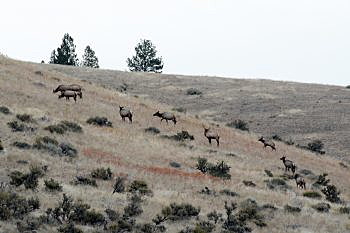
-Laura Lundquist reporting for the Missoula Current
The elk that normally occupy the slopes of Missoula’s North Hills will have a few less hunters pursuing them this fall.
On Wednesday, the Fish, Wildlife & Parks Commission spared no time in granting the request of FWP biologist Liz Bradley to reduce the number of elk tags for the area north of Missoula, especially in the Rattlesnake Wilderness and National Recreation Area.
Rifle hunters will still be able to hunt for bulls during the regular season, but Bradley reduced the number of antlerless “B” elk tags – which are usually cows, although they can be young bulls – to one obtained only through a special drawing. Hunters who already bought the over-the-counter elk B license can still use it in other Region 2 hunting districts.
Bradley saw the need for such a move this spring after counting elk populations around Missoula. While other herds, such as the ones on Mount Jumbo or west of Evaro, saw some slight population decreases, the North Hills herd lost half its numbers since 2016, now totaling less than 150. In 2011, biologists counted 450.
“I’m not concerned the herd is disappearing – the population (size) is at the place where it was in the late ‘90s before it took off,” Bradley said at the end of May.
Still, she wasn’t seeing many calves in the herd, and the past few snowy winters may have something to do with that. So having a few more cows around might help boost the population.

FWP biologists can be reluctant to reduce hunting opportunity and they know population numbers rise and fall with the years, depending on how many animals die during hard winters or summer droughts.
It’s also difficult to change the number of hunting tags to be offered after the commission has already approved the biennial hunting quotas and regulations have been published. But after three years of decline, Bradley felt confident that she needed to take action.
Big game chief John Vore backed Bradley’s recommendation Wednesday.
“This is somewhat of an exception to our usual course of business here, in that we typically adopt season types and season structures biennially. However, there are occasions that arise when we have to make changes outside of that cycle,” Vore said. “This proposal is to address a large decrease in the number of observed elk in the North Hills-Evaro unit.”
It didn’t hurt to have the support of local hunters, members of Hellgate Hunters and Anglers and North Hills landowners.
Bradley said she would consider the move a success if the population rises above 240 elk again, preferably to around 300.
Missoula region commissioner Tim Aldrich said elk move around, but this was different.
“Liz Bradley has done a heck of a job trying to figure out where in the world they went. This herd is typically so easy to find. They’re not there,” Aldrich said.

